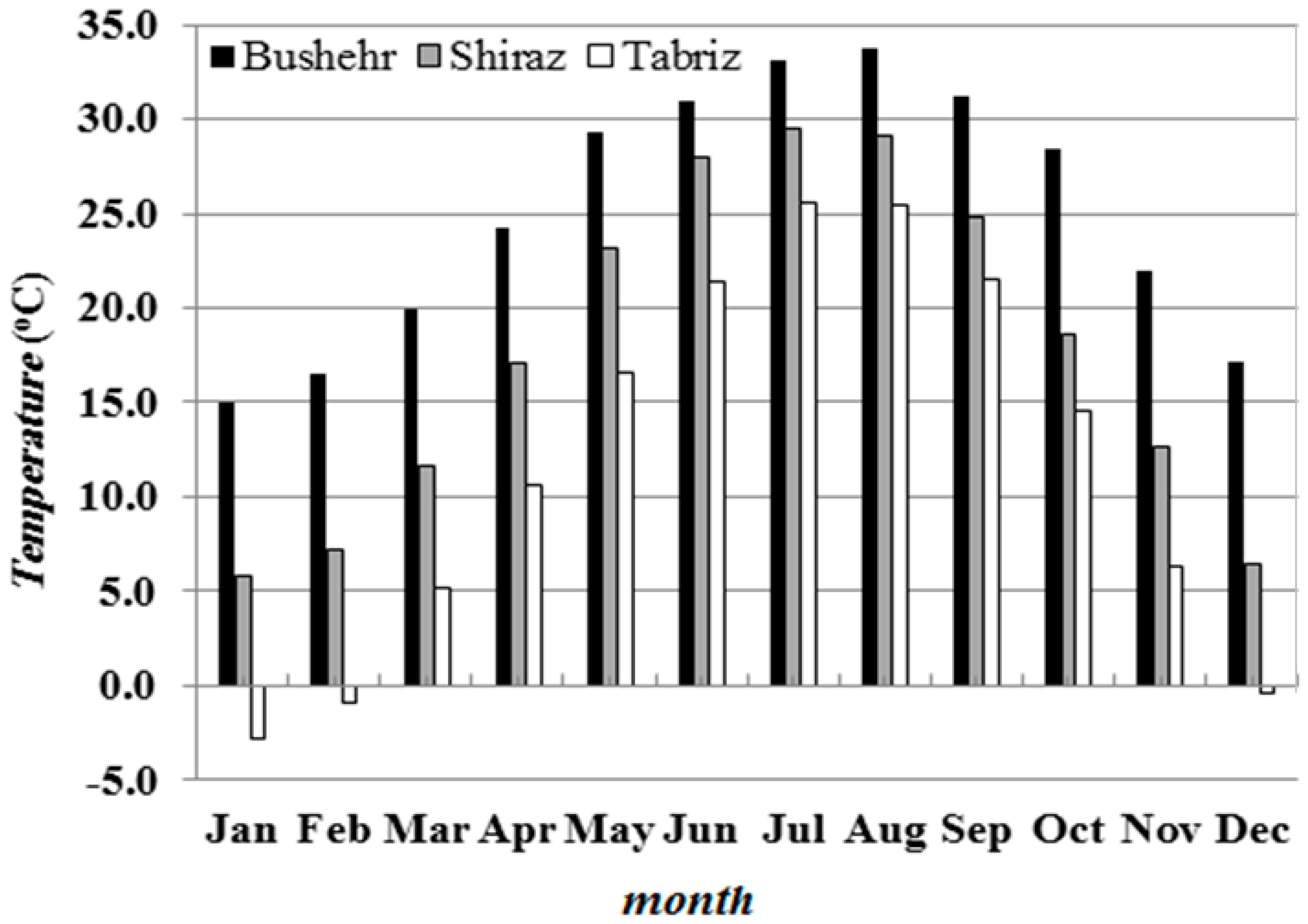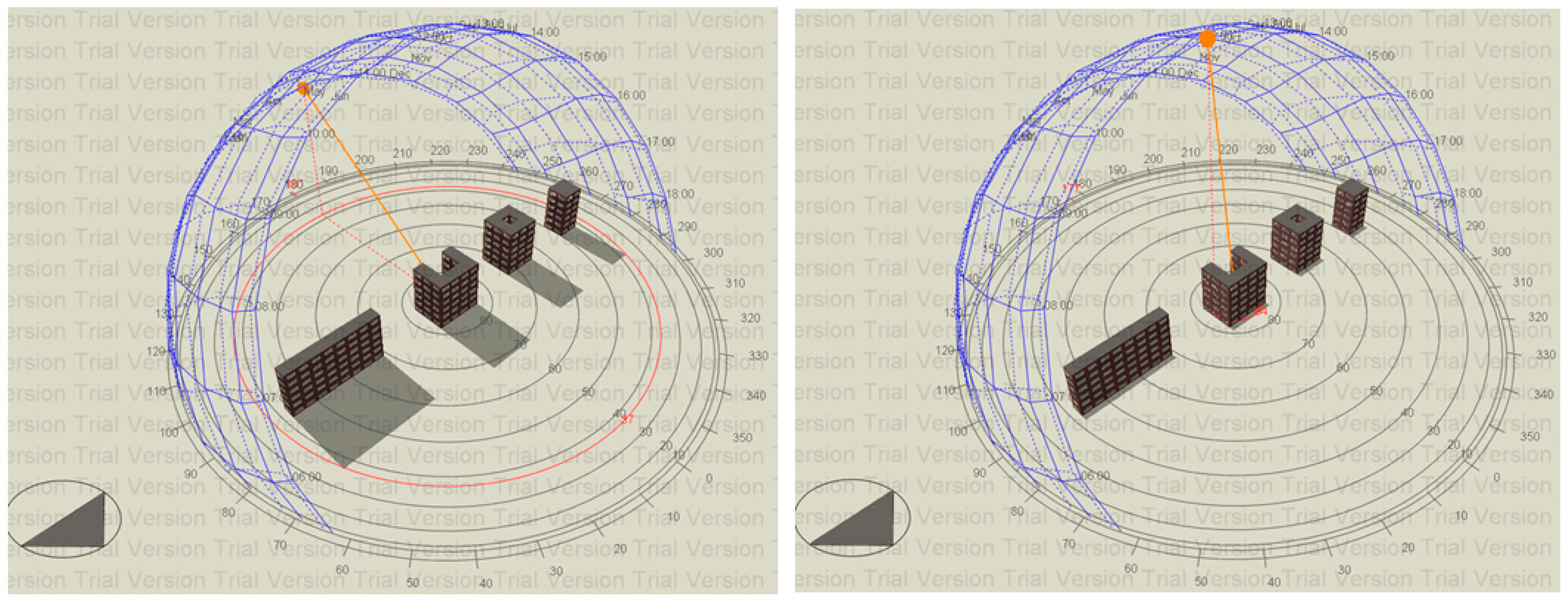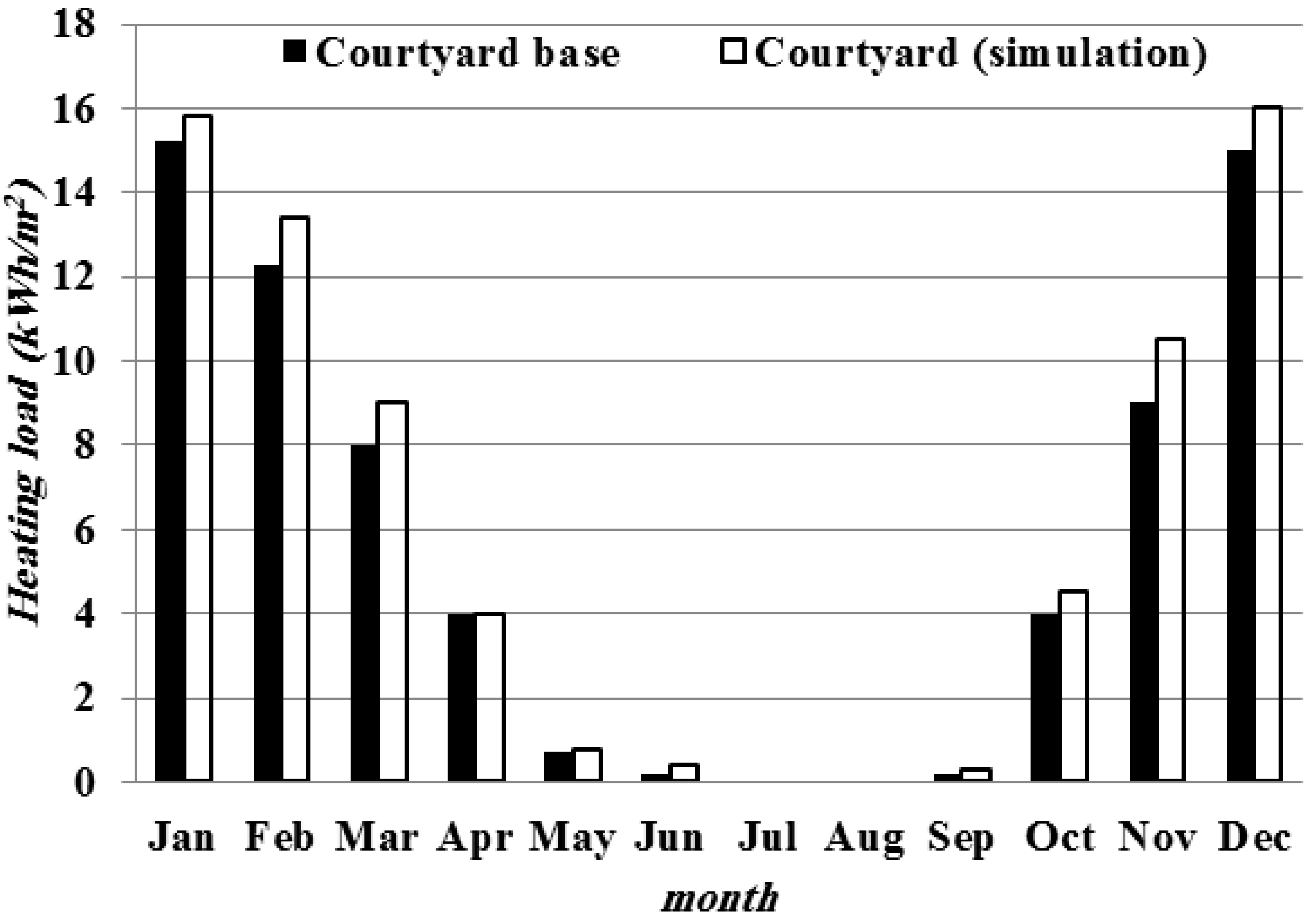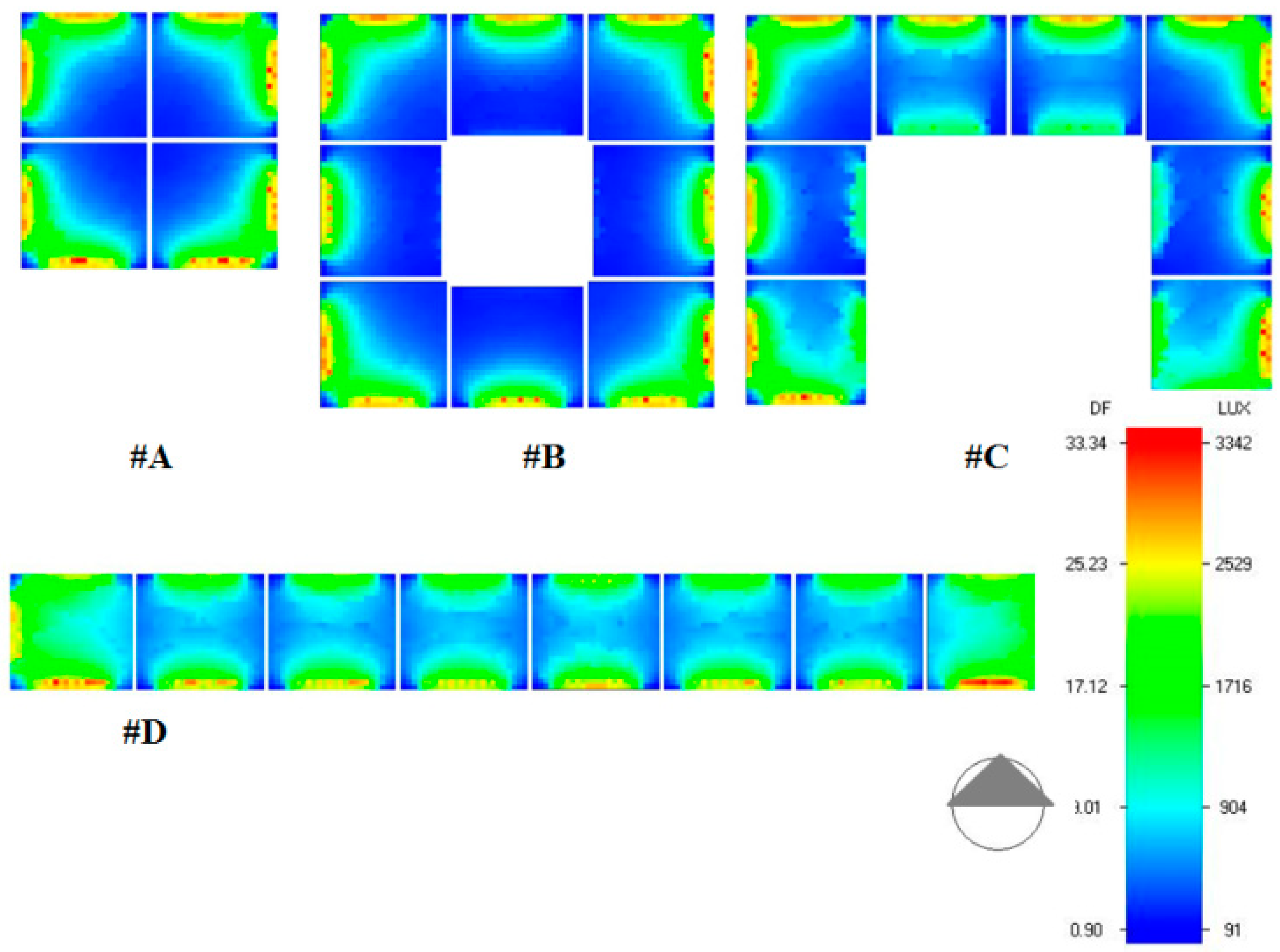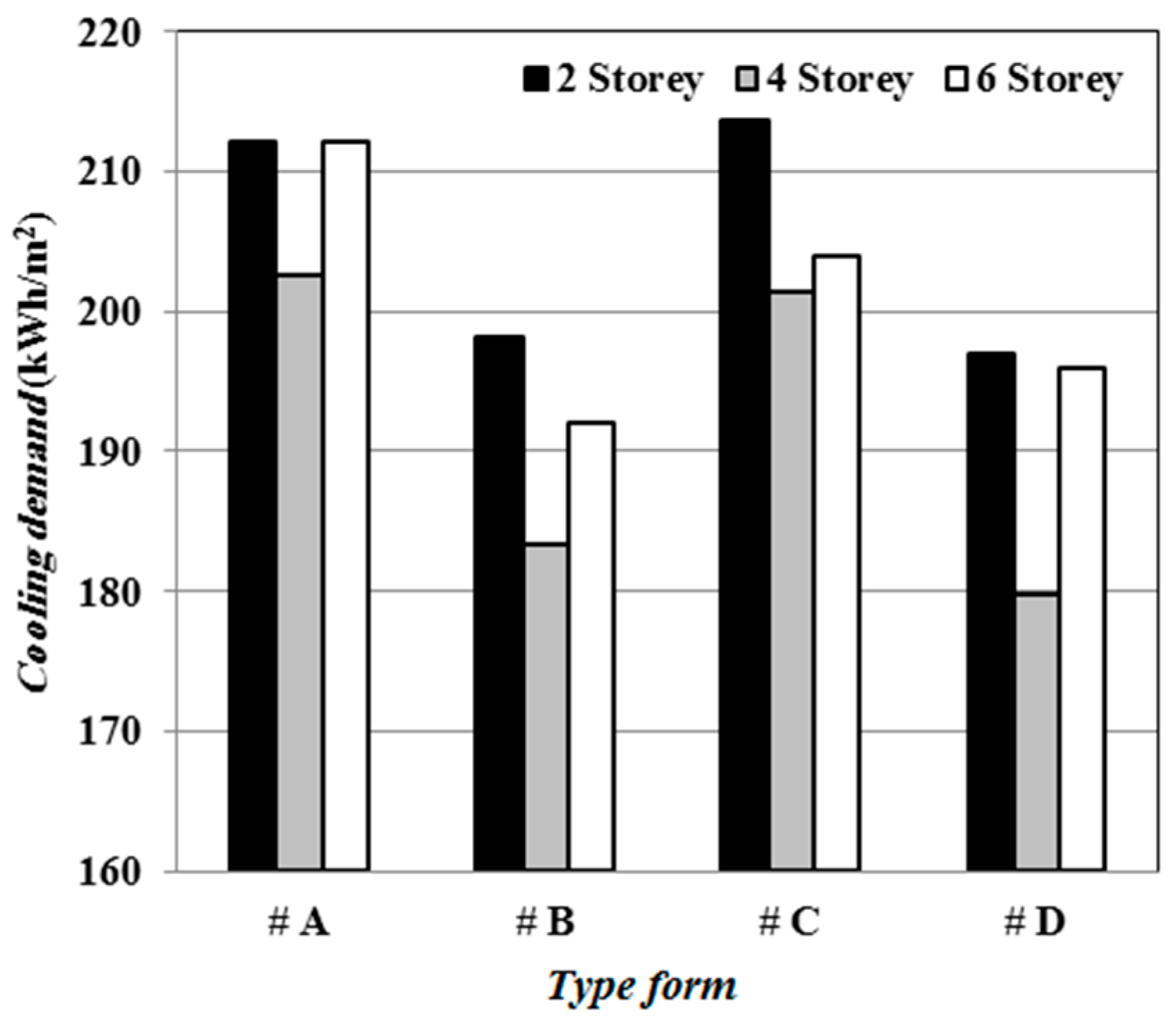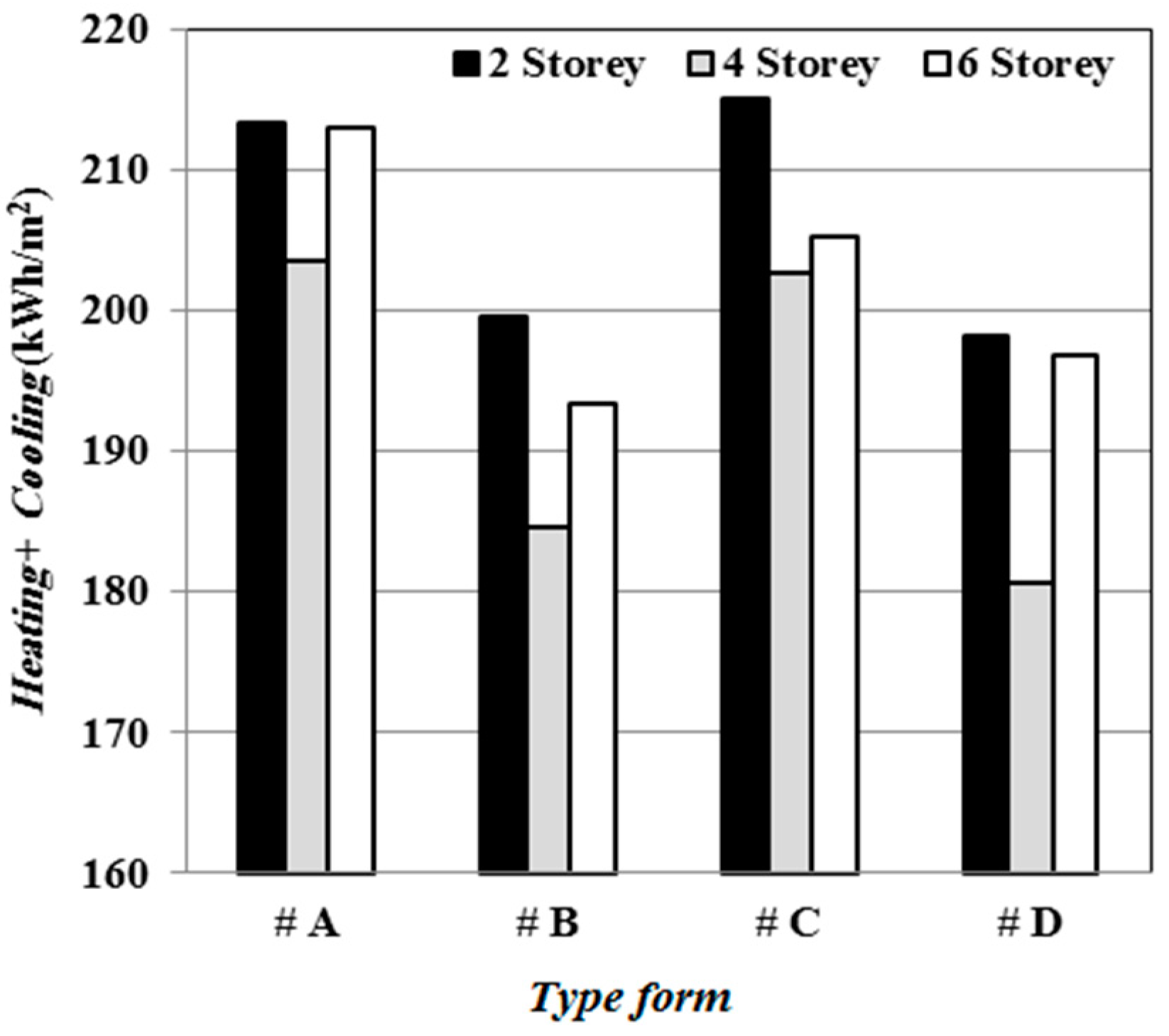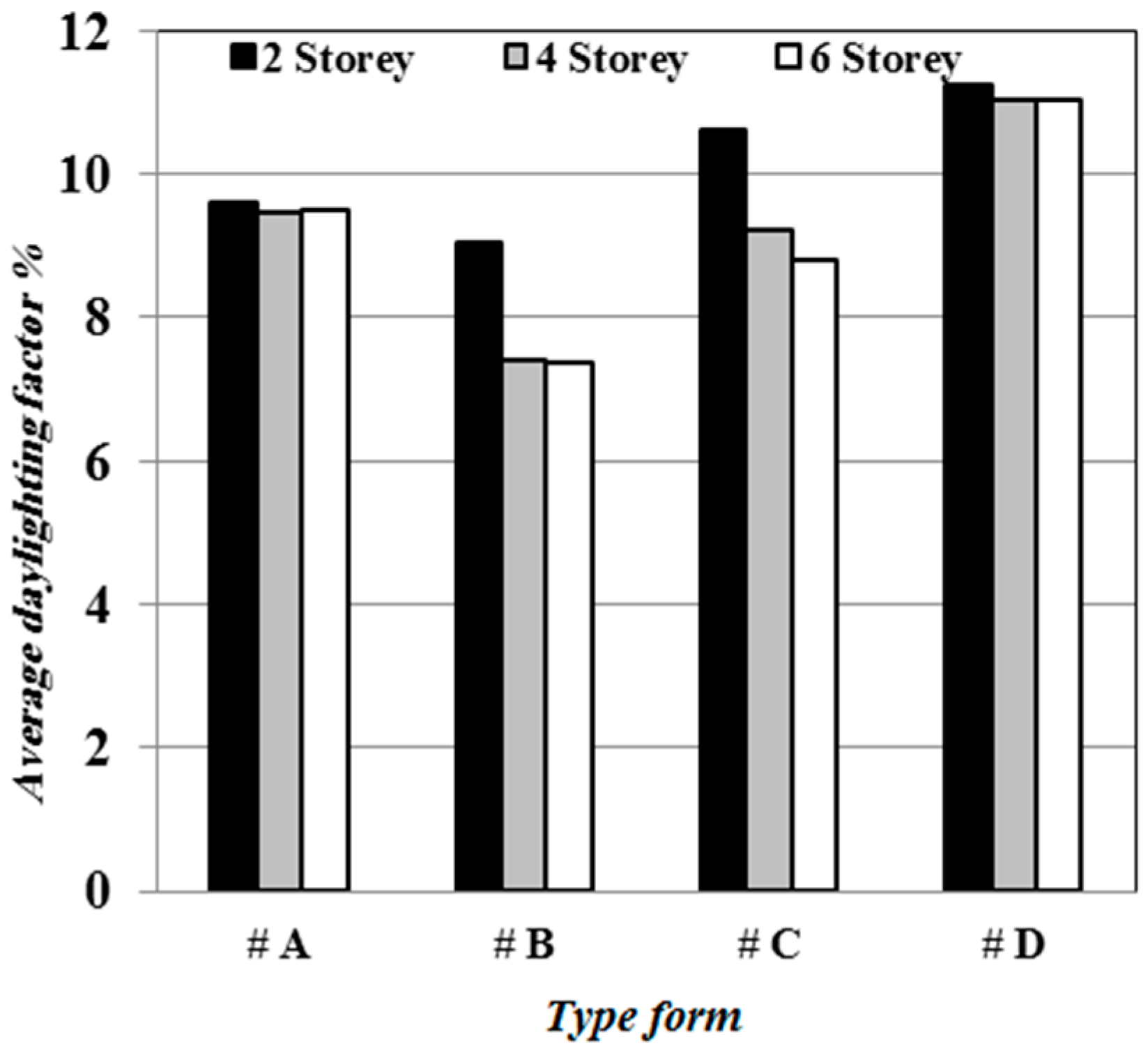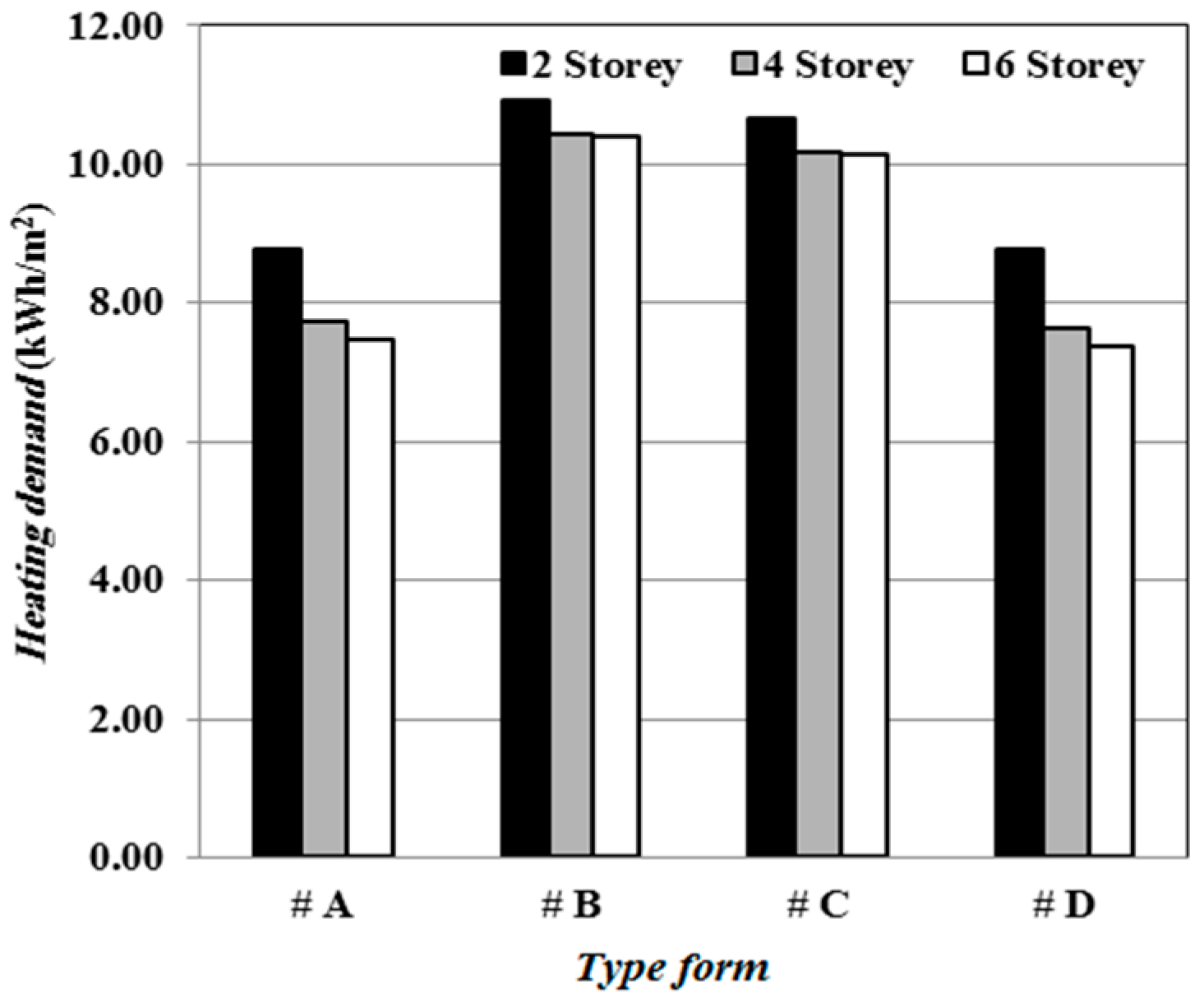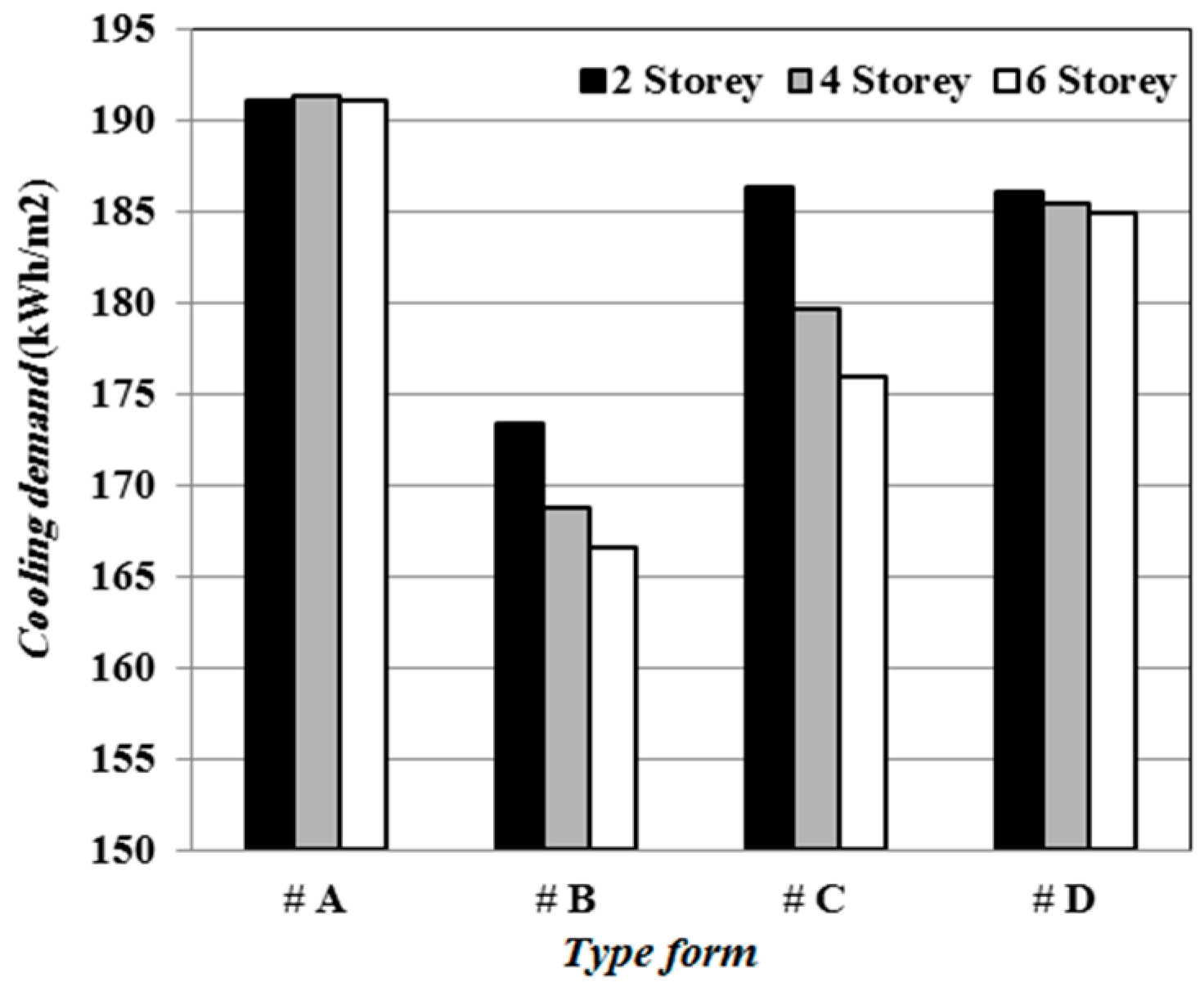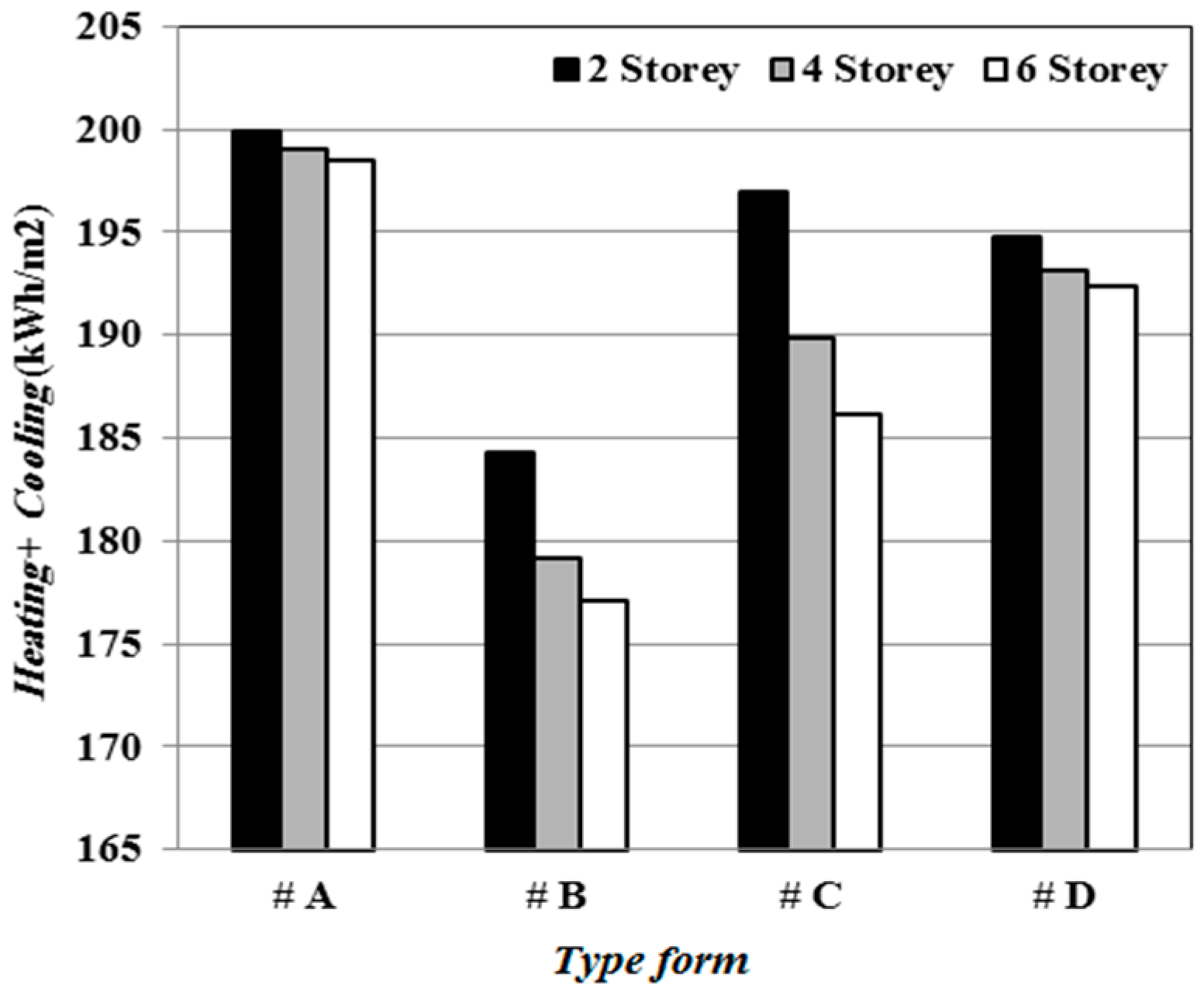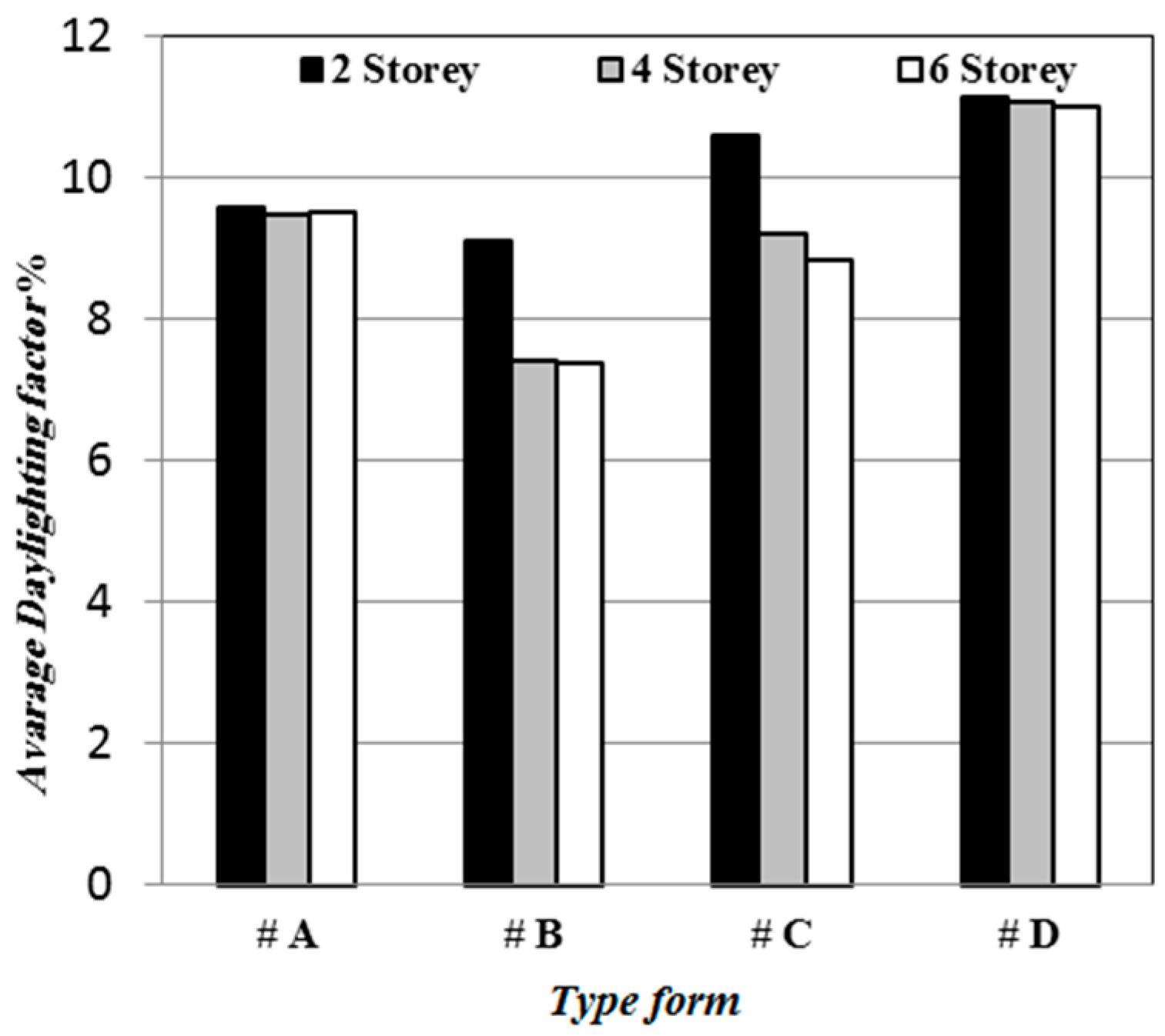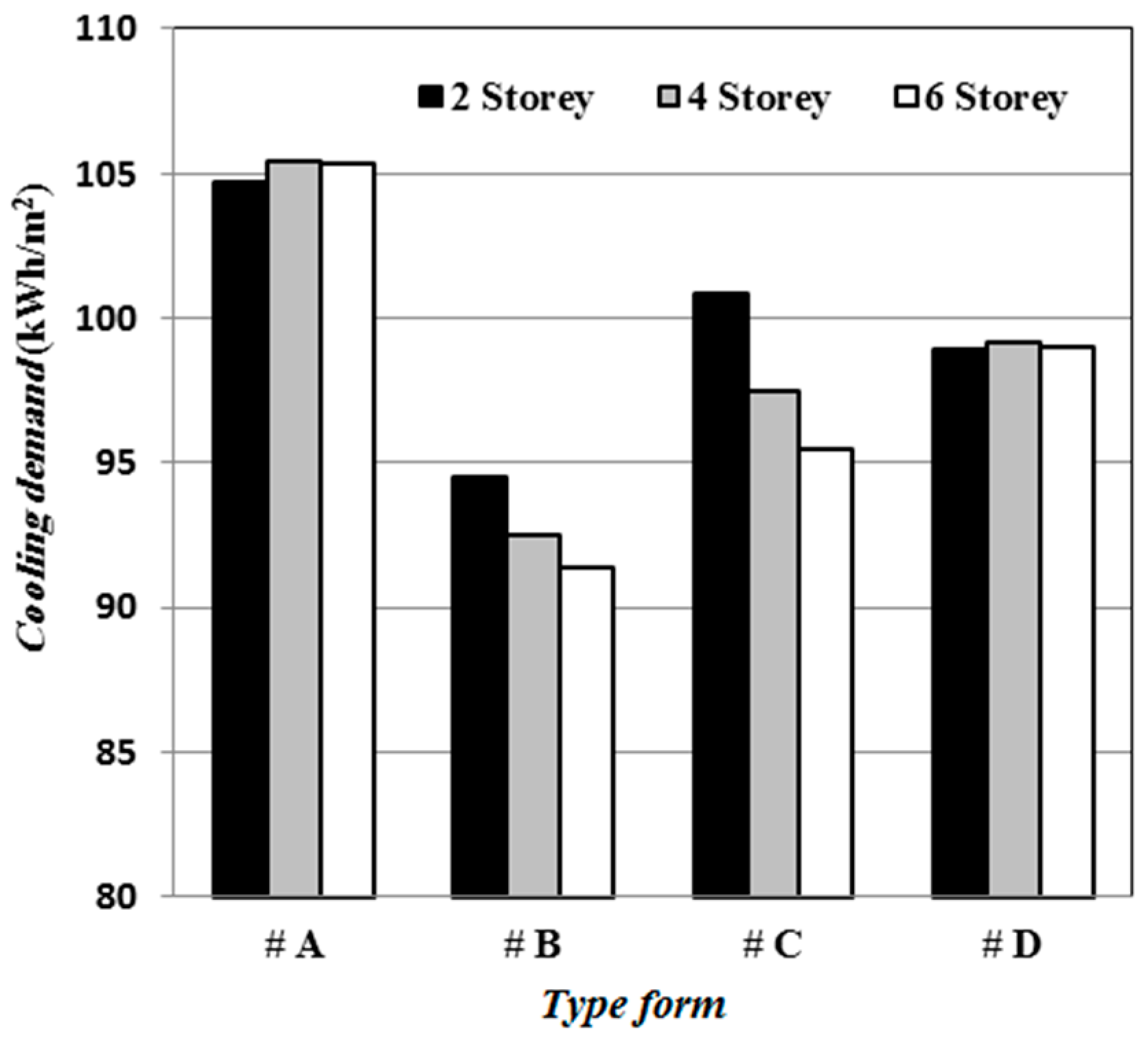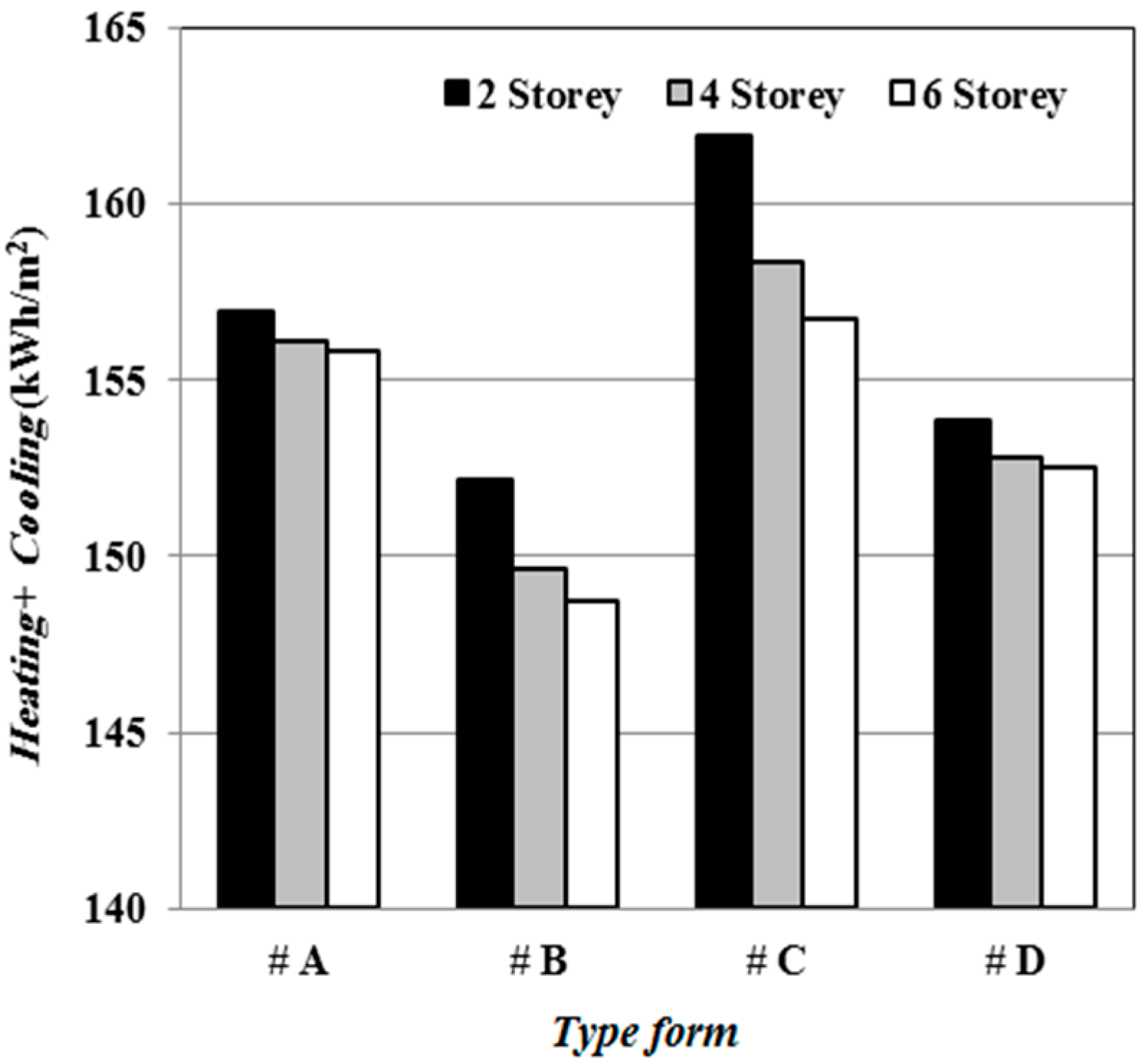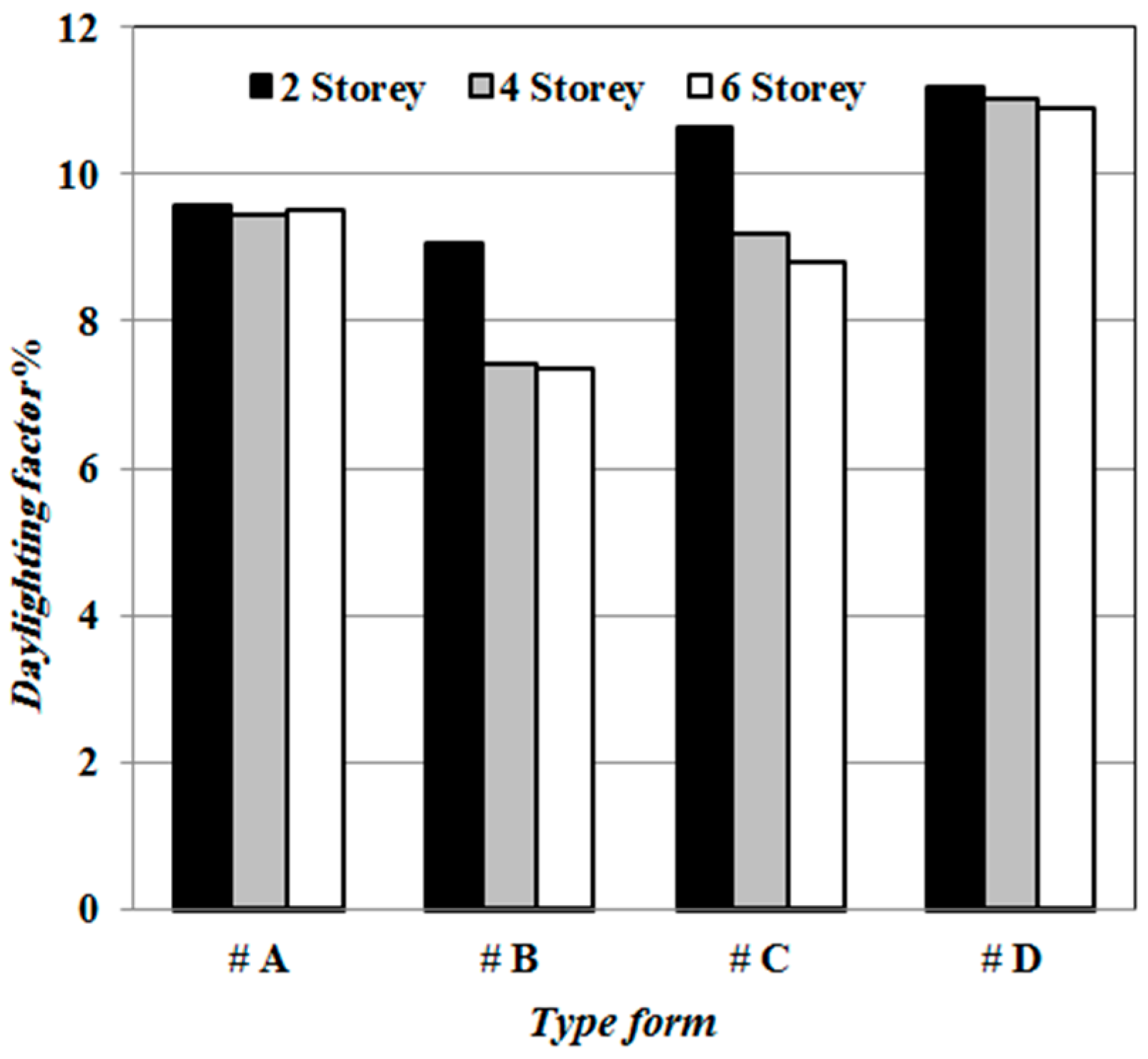1. Introduction
After the Industrial Revolution, the use of fossil fuels has significantly increased in order to enhance the thermal comfort of the indoor environment. This, in turn, has revealed the remarkable share of energy consumption that is allocated to the construction sector, where cities are responsible for 70% of produced carbon in the world [
1]. Today, 50% of the world’s population lives in cities, and this number will grow up to 80% by 2030 [
2], which makes energy savings for buildings an absolute necessity [
3]. One way to reduce the energy consumption and greenhouse gases of buildings, is the reformation of the building forms [
4], where, by the proper design of urban blocks and utilization of solar energy, and also by paying attention to lighting, ventilation, wind direction and building density, up to 50% of energy consumption can be saved [
5]. Architects and urban planners have studied the relationship between building form and energy consumption. The relationship between the building and its surrounding environment is an interdisciplinary challenge for architects, urban planners and environmental engineers [
6]. Urban planning addresses the impact of urban blocks on the outdoor thermal comfort, and architects examine the effect of the building form on the indoor thermal comfort and building’s energy consumption [
7].
Yamaguchi et al. [
8] investigated the impact of form and type of urban block on building energy consumption and concluded that by designing the appropriate form and type of building blocks, the amount of carbon dioxide produced by the buildings can be reduced from 90% to 60%. Vartholomaios [
9,
10] examined the energy consumption of several types of building forms in the Mediterranean climate by utilizing the Energy Plus software, and revealed that the linear block with the east-west direction was the most suitable mode in order to receive sunlight, and gave the best performance in terms of energy consumption. Taleghani et al. [
11] also investigated the impact of residential buildings on energy consumption and lighting in the Netherlands by means of the Design Builder software with respect to simulating the energy and lighting consumption. Hence, by comparing the three forms of single, linear, and central courtyard buildings in the three different modes of one, two, and three-stories, they realized that the central courtyard form was 22% less energy-consuming than the single form building and had 9% lower amounts of discomfort, which is assumed to be the best mode for designing. Studies have shown that using a central courtyard can have a significant impact on reducing energy consumption. Steemers et al. [
12] proposed six forms of urban patterns according to the archetype buildings, including pavilions, slabs, terraces, terrace-courts, pavilion-courts and courts. In this study, it was found that the represented forms of the archetype patterns are environmental friendly and are considered to be in line with the lighting criteria. Additionally, it emphasized that the central courtyard has the best performance among the other six archetype patterns. Ratti et al. [
13] also did a similar analysis for the central courtyard form in the Moroccan hot climate and pointed out that it could be an optimal form to reduce energy consumption among building forms.
In another study, Okeil [
14] created a constructional form known as “the solar building block”, and compared it with the two conventional forms, and proposed the energy efficient form, in which the solar residential block had the lowest energy consumption in hot-humid climates at 25 °C north latitude. In another study, Yang et al. [
15] examined the Bijing’s weather parameters and their effect on the interior comfort of urban blocks. It was observed that the height of the blocks, the thermal mass, the material heat transfer and the surface radiation are important factors in the comfort of the building.
The direction of office buildings has a great impact on energy consumption. This was experimentally shown in a study which was conducted in Hashtgerd city, with a hot-dry climate. This study illustrated that expanding the surface of the southern facade of the building by means of increasing the buildings’ direction has a favorable result, however, this action will simultaneously incline the surface of the thermal envelope and inflate the energy waste of the building. Meanwhile, increasing the surface of the southern facade beyond the optimal limit results in receiving energy radiations and the emergence of a heating period, which is not desired or may lead to an increase in absorption of radiant energy during the cooling period. What matters is that this absorption plays a negative role and thus inflates the cooling energy consumption of the building. In addition, the study revealed that the east-west direction has much better performance than the north-south direction in terms of total and primary energy consumption, which usually occurs in most north-south directions [
16].
Research conducted in the realm of reducing energy consumption has all been done in order to provide comfort for residents (i.e., supplying light, temperature and ventilation) and with the appropriate design of the building, all studies were able to significantly reduce energy consumption. As mentioned before, office buildings have been assumed to contribute a large part of energy consumption in the construction sector, and yet, no research has been conducted to examine the relation of the form of office buildings to its impact on energy consumption and lighting in the climate of Iran. Accordingly, this study attempts to investigate the below mentioned purposes.
A comparison of the four forms of archetype patterns in order to find the most appropriate form of office building in relation to the cooling, heating, and natural daylight loads for the cold, hot-humid and hot-dry climates of Iran;
An investigation of the theory that the suitability of the archetype form with regard to the central courtyard pattern for buildings [
11,
12,
13] could be appropriate for buildings with administrative usage in the Iranian climate.
The first step in designing environmental friendly architecture is to study the climatic factors of the location. According to the cluster classification of the coupon, Iran has four different climates including hot-humid, hot-dry, cold and mild-humid [
16]. In this research, the cities of Shiraz with hot-dry climate, Tabriz with cold climate and Bushehr with hot-humid climate were examined as samples of Iranian climates.
The prevailing wind in Bushehr, is north-west, with an annual average wind speed of 2.5 m/s, and also the annual average temperature of Bushehr is 25 °C. In addition, the annual average diffuse horizontal solar for the city of Bushehr is 73.3 kWh/m2 and the annual average of direct normal solar for this city is 95.8 kWh/m2.
On the other side, the prevailing wind direction in Tabriz is west with an annual average of 3 m/s and the average annual temperature in this city is 11.9 °C, which indicates that building heating is a crucial point. The annual average of diffuse horizontal solar for Tabriz is 76.2 kWh/m
2. Meanwhile, the city of Shiraz, which is located in a hot-dry region with an average annual temperature of 17.8 °C, has the prevailing wind directions of north and north-west, and also the annual average wind speed in Shiraz is about 2.2 m/s. In addition, the annual average diffuse horizontal solar for Shiraz is 110.2 kWh/m
2.
Figure 1 illustrates the average monthly temperatures of the cities of Tabriz, Bushehr and Shiraz through ten years. Tabriz has a cold climate in most months of the year. Bushehr possesses the highest average temperature almost through all of the months of a year, which is between 15–33 °C, and Shiraz has a minimum temperature of 5.8 °C in January and a maximum temperature of 28.1 °C in July.
2. Methodology
In this study, four types of building forms were considered in order to investigate the impact of the form of the office building on the amount of cooling and heating energy consumption in Shiraz, Tabriz and Bushehr [
12,
15]. The forms are from archetype patterns which are among conventional forms of office buildings [
17]. According to
Figure 2, the first form is singular, the second form has a central courtyard, the third form is the U and the fourth form is linear. The forms are named with #A, #B, #C and #D characters, respectively. As it is obvious in
Figure 2, the first form is 1000 m
2 and the next three forms are equally 2000 m
2. In order to compare the cooling and heating loads of the buildings, these values are expressed in terms of square meters (m
2). In this research, four forms of office buildings are studied in three different modes, two story, four story and six story modes; these are the most common modes for constructing office buildings [
18].
For the purpose of simulating the energy and natural lighting of the buildings, the DesignBuilder software [
18] was utilized. The DesignBuilder software is one of the most powerful softwares in the realm of simulating building energy. Additionally, the Plus Energy Analysis Engine was used in order to simulate the building energy and radiance engine for natural light analysis. This software is capable of considering all of the detailed aspects of the building and for each city, with different climates, simulations can be conducted per hour through various time intervals. For instance,
Figure 3 indicates the solar graph of a six-story building in Bushehr, which was simulated two times, once on June 21 (Summer Solstice) and another time on December 21 (Winter Solstice) at 12:00 p.m. Due to the small difference between the solar graphs of the studied cities, only the diagrams of Bushehr are represented as samples. In order to simulate the selected forms, at first, the climate data of the studied cities were collected from the Meteorological Organization for the period of 2006–2016 and then they were inputted into the DesignBuilder software separately for each city; Afterwards, separate EPW files were created to ensure that the data are sufficiently valid.
In addition, in this research, natural ventilation was applied to the software settings, in order to consider the movement of air based on the heat and cold. Also, during the days of the year when the outdoor weather is favorable, natural ventilation replaces mechanical ventilation, and so this brings the experiment data closer to the real conditions. In all of the studied forms, a chiller is used for cooling and heating. For the purpose of simulating the heating and cooling set points, 22 °C and 24 °C base on ASHRAE standard, respectively, were used. In the buildings, the surface area of the glass for the outside facade was considered to be 30%. The utilized materials in buildings were also considered similarly. Accordingly, the containing layers of the outside wall, the roof, and the type of glass are shown in
Table 1.
4. Results and Discussion
Daylight has a crucial role in office buildings in terms of energy consumption, lighting, cooling and heating. In
Figure 5, the daylight is illustrated in the four different forms. The radiance represented by the DesignBuilder software was used in order to analyze the daylight.
Figure 5 shows the daylight value at an altitude of 0.75 from the surface of the earth, which is represented as the height from the ground according to the ASHRAE standard. As shown in
Figure 5, the #D form receives the highest amount of the light, due to the fact that it has the largest facade in the south. Also, after the linear form, the U form shape possesses the most direct and diffuse light. Meanwhile, the central yard shape has caused the building to receive direct light from the outside, in addition, from the inside of the central courtyard, light enters like it is diffused into the office rooms.
Knowing the shape of the wind flow when it is striking the building, can help us to understand the energy consumption of the inside of the building. When a part of the building is exposed to the wind during cold months, it causes an increase of heat loss at the walls, and during the hot months, it increases the cooling load of the building [
19].
Figure 6 demonstrates the shape of the wind flow when it meets the studied building forms for different cities. For each individual city, the wind speed and wind direction were calculated with the assistance of numerical calculations; Accordingly, the annual average velocity and prevailing wind direction were calculated too. The prevailing wind direction in Bushehr is north-west with a speed of 2.5 m/s. The prevailing wind for Shiraz is also north-west with a speed of 2.2 m/s and for Tabriz the prevailing wind direction is west with an average speed of 3 m/s.
As indicated in
Figure 6, in the cities of Bushehr and Shiraz, the northern and western facades of the buildings which are exposed to the wind, cause the areas located in the north and west of the building to consume more energy through the cold months. This is due to heat that is wasted through the walls. Besides, during summer, in periods where the weather is mild, wind can be used as natural ventilation for the building, and in hot seasons when the air temperature is higher than comfortable, it can increase the cooling load of the northern and western areas. In addition, the west wind flow, which has exposed the building forms in Tabriz, has resulted in heat loss of the inside of the building for the western areas through the cold months of the year.
The annual heating consumption of office buildings in Bushehr are illustrated in
Figure 7. As shown in
Figure 7, the lowest annual heating consumption amongst the building forms of two, four and six stories belongs to the linear form; this is because it has the highest light gain in the northern and southern facades (
Figure 5) and additionally, the exterior surfaces of the building are more exposed to the sun. In the second place after the linear form, the single form has the lowest heating load. This is also because all of the areas which are receiving light from all around, and, the daylight, in turn, helps the indoor environment to be warmed up. Meanwhile, the outer surfaces are more exposed to sun rather than the U form or the central courtyard form and thus have less shadowing on the outer surfaces. The two forms of the central courtyard form and the U form have almost the same consumption and possess almost 25% more energy consumption from the aspect of heating in comparison to the linear form.
The annual cooling consumption of the office buildings of Bushehr is illustrated in
Figure 8. As shown in
Figure 8, the linear form among the other forms of the two-story modes, has the lowest energy consumption from the aspect of cooling load, and then the central courtyard form, the single form and the U form have the lowest energy consumptions, respectively. In four-story building mode, the lowest energy consumption for cooling load belongs to the linear form, central yard form, U form and single form. In the six-story mode, the central courtyard form has the least energy consumption from the aspect of cooling load, and then there take place the linear form, U form, and single form, respectively.
The total cooling and heating loads per square meter, for all building forms in Bushehr are shown in
Figure 9. According to
Figure 9, among the building forms through the two-story modes, the linear form has the lowest energy consumption, and then the central courtyard form, single form and the U form, in ascending order. Among the four-story building forms, the energy consumption from lowest to the highest belongs to the linear form, the central courtyard form and the U form. Additionally for the six-story building, the central courtyard form has the least energy consumption and afterwards from lowest to the highest, is the linear form, the U form and the single form.
Figure 10 shows the normal daylight amount of all building forms for Bushehr during the year. According to
Figure 10, the linear form in all of the three modes of two, four and six-story buildings has the highest amount of daylight; this is due to the largest surface which belongs to the north and south facades where it receives the most amount of sunlight (
Figure 5). The U form and the single form receive approximately 15% lower amounts of daylight than the linear form and the central courtyard form also receives 39% lower amounts of natural daylight than the linear form.
Figure 11 demonstrates the annual amount of heating per square meter for all of the building forms in Shiraz. As shown in
Figure 11, the linear form has the least heating consumption, and next is the single form, the U form and the central courtyard form, from lowest to the highest consumption. The reason for the low consumption of heating regarding the linear form is because the outer surfaces are more exposed to the sun in comparison with the other forms (
Figure 3 and
Figure 5).
Figure 12 shows the amount of cooling energy consumption per square meter for all building forms in Shiraz. According to
Figure 12, the central yard form in the two, four and six-story modes has the lowest energy consumption. Because the central yard form creates the most shading on the outer surfaces (
Figure 3), the light inside the central courtyard enters the building’s zones in a diffuse way (
Figure 5). The amount of energy for the cooling purposes are equal both in the linear and the U form modes for the two-story buildings. In addition, the single form has the maximum energy consumption through all modes, because the minimum shading is applied on the outer surfaces of the building (
Figure 5).
Figure 13 shows the total average of heating and cooling per square meter for all forms during a year in Shiraz. According to
Figure 13, the central yard form has the least energy consumption in all modes. In terms of energy consumption, after the central courtyard form is the U form, linear form and single form, from the lowest amount of consumption to the highest amount. Among the forms in the two-story buildings, the linear form consumes 6% more energy than the courtyard form and also the U form consumes 7% more energy in comparison with the central courtyard form, and finally the single form consumes 9% more energy than the central courtyard form.
Figure 14 demonstrates the average amounts of natural daylight through all forms of buildings in Shiraz during a year. According to
Figure 14, the linear form has the most daylight among all forms of buildings, because it has the highest surface in the north and south facades and receives the highest amounts of sunlight (
Figure 5). The U form and single form receive approximately 16% lower amounts of light than the linear form, and the central yard form receives 39% lower amounts of normal daylight in comparison with the linear form.
Figure 15 illustrates the average heating energy per square meter regarding the forms for Tabriz during a year. As shown in
Figure 15, the single form and central courtyard form in all modes consumed the least amount of energy for heating. This is because they have the highest amounts of exterior exposure to sunlight. The other forms, from the lowest to the highest, are the central courtyard form and the U form.
In
Figure 16, the average energy required for cooling of the studied forms is shown in Tabriz in per square meters.
Figure 16 demonstrates that the central courtyard form has the least energy consumption in all modes, because the central courtyard form implies the most shading on the exterior surfaces of the building (
Figure 3), and the single form has the highest energy consumption because it has the lowest shadowing at the outer surfaces (
Figure 3). The two-story linear form has the lowest energy consumption after the central courtyard form. The U form in the four and six-story modes has the lowest energy consumption after the central courtyard form.
Figure 17 illustrates the total average monthly energy consumption for the cooling and heating loads in Tabriz through all of the simulation modes. According to
Figure 17, the central yard form has the lowest energy consumption, followed by the linear form, single form and U form, from the lowest amounts of consumption to the highest amounts of consumption.
Figure 18 shows the average amount of natural daylight among all building forms in Tabriz during the year. According to
Figure 18, the linear form receives the maximum natural light due to the fact that the highest external surface of the building is on the southern facade, and its east-west direction has resulted in the highest amounts of light (
Figure 5), and in all cases, the central courtyard form receives the lowest amounts of light. Meanwhile, among the two-story buildings, after the linear form is the U form and the single form, from the aspect of obtaining more light and thus more decent functions. In the four-story buildings, the U form gains 4% more lighting than the linear form. In addition, in the six-story building, the single form receives 8% more natural daylight than the U form.
5. Conclusions
In this research, four different archetype patterns (single form, central courtyard form, U form and linear form) were investigated in the two, four, and six-story building modes with the office usage, in order to determine the most appropriate form of office building from the aspect of examining cooling, heating and natural daylight for the cold, hot-humid and hot-dry regions of Iran. In addition, a theory of the suitability of the archetype pattern for the central courtyard form with respect to energy and lighting consumption for office buildings [
11,
12,
13] in the hot-humid climate of Bushehr, hot-dry climate of Shiraz and cold climate of Tabriz, was determined. The conducted calculations approved that the archetype patterns are suitable to be applied, especially on the central courtyard form, from the perspective of energy consumption, which was investigated in the cities of Shiraz with hot-dry climate and Tabriz with cold climate. It is somehow different for the hot-humid climate of Bushehr as the central courtyard form does not show a suitable performance in terms of lighting. The summarized results are represented specifically for each city below:
Among the two-story building modes, the linear form has the least energy consumption, and then the central courtyard form, the single form and the U form. Additionally, among the four-story building modes, the linear form, the central courtyard form, the U form and the single form have the least to the most energy consumptions, respectively. For the six-story building mode, the central courtyard form has the least energy consumption and subsequently, from the least to most amount of consumption, is the U form and the single form. The U form and the single form receive approximately 15% lower amounts of daylight in comparison to the linear form, and the courtyard form receives 39% lower amounts of natural daylight in comparison to the linear form.
In Shiraz, the central courtyard form has the least energy consumption through all modes. In terms of energy consumption, after the central courtyard form is the U form, the linear form and single form, from least to most energy consumption. In terms of receiving natural daylight, the linear form has the highest amounts of daylight among all the other building forms. The U form and single form receive approximately 16% lower amounts of lighting than the linear form, and the central courtyard form receives 39% lower amounts of natural daylight than the linear form.
In the city of Tabriz, among all of the building modes, the central courtyard form has the lowest energy consumption, and afterwards, in order from least to most, is the linear form, the single form, and the U form. In terms of natural daylight, the linear form receives the most natural daylight through all modes, and the central courtyard form receives the minimum amount of lighting through other modes. Among the two-story building modes, after the linear form, the U form and the single form have decent function in terms of obtaining more lighting. In the four-story building modes, the U form receives 4% more lighting than the linear form, and additionally for the six-story building modes, the single form receives 8% more natural daylight in comparison with the U form.
By the numerical analysis and the direction of the wind flow regarding its collision with the building forms, it is concluded that for the cities of Bushehr and Shiraz, the northern and western building facades are exposed to wind flow. This, in turn, causes heat loss through the walls at the northern and western areas of the building during the cold months and thus more heating energy is consumed. Meanwhile, in the summer season, when the air temperature is mild, the wind flow can be used as natural ventilation for the building. In addition, in the hot seasons where the air temperature is higher than the comfort level, it increases the cooling load at the northern and western parts of the building. Finally, the west wind flow which is blown at the building forms in Tabriz, results in heat loss of the inside of the building at the western areas through the cold months of the year.
This study shows that understanding vernacular patterns and traditional architecture could be an effective way in sustainable design and energy consumption. There are many patterns in building physics that could be revised and upgraded to reuse and reorganize in modern architecture.
